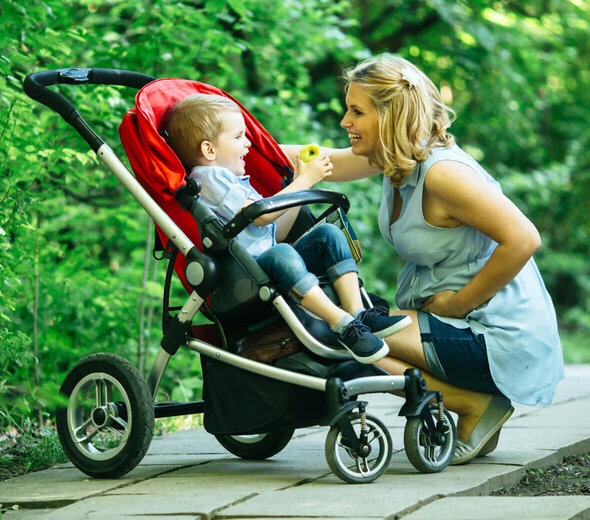

You are already in the hall and yet keep on wondering… if he does not have too many of those layers on? You go to the balcony, look at the thermometer. No, he is not dressed too warm, you would even add something, but you do not know what. Does it happen often to you? Beginnings are always hard. How to dress the baby for a walk, so that he is not overheated or cold? Take it easy, there are some rules which will be of help when choosing clothes.
There is one simple rule working for small babies that cannot yet talk, and which applies regardless of the season. If you want to check whether the baby is warm or cold, touch his nape. When it is wet, then the baby sweated and is dressed too warm. Overheating is as dangerous as freezing and may result in illness. The nape should be warm and dry, then you know the baby is neither too hot or too cold. I followed that principle whenever I had doubts, and it was reliable.
Newborn:
When to go for a walk: it is recommended to take a newborn for a walk after the first week. A few days after getting home from the hospital you can organise a so-called "airing". Place the baby in a pram on a balcony or in a garden for about 10 to 15 minutes (or longer, when the temperature is above 20°C). The airing can be extended every day by 5 -10 minutes. After 3 - 5 days you can go for a walk (for about an hour). When it is cold, windy or raining, air the baby.
Clothes
Remember! The baby lays in the pram. You should dress him warmer than yourself, because he does not move.
Infant:
Clothes:
1. Buttoned one-piece
The most convenient system - with snaps opening from the crotch.
2. Socks
If the suit does not cover feet, put comfortable cotton socks on the baby's feet.
3. Jumper
It may be necessary even at home, when it is already cold, and the heating is still off.
4. Cap and gloves
Selecting a cap take into account the temperature oudoors. The best are soft cotton caps, that do not irritate the baby's delicate skin .
5. Jacket
The baby should wear a jacket on warmer and windless spring days. When it is cold and the baby is in a deep pram, you can dress him in a suit, but not too warm one.
6. Trousers
If you dress the baby in a jacket, match trousers and tights to it. From my own experience, however, I recommend a light suit, which is much more comfortable.
7. Shoes
When the baby does not walk yet, you should select soft shoes without a hard sole. Later, when the baby starts to walk, it is best to invest in profiled shoes.
Spring is a season with a very changeable temperature. Often, although it is sunny outside, it is not warm at all. It is good to have additional clothes in your bag, or be able to take something off. For laying babies an additional blanket is enough.
Remember! When the baby sits in a buggy, you should dress him warmer than yourself. The baby moves only a little, while you are walking. When the baby plays, walks, runs, dress him a little lighter than yourself.
Newborn:
When to go for a walk: recommendations are similar as in the spring. Additionally, avoid a very high temperature. When it exceeds 30°C, resort to "airing".
Clothes
Dress the baby in the same number of layers as yourself. The only difference is that no skin should be left exposed on his hands, legs or feet as it may easily be burned. Remember about a cap, protecting your baby's eyes and head.
Infant:
When to go for a walk: the best time is in the morning (before 10 a.m.) or in the afternoon (after 4 p.m.), when the heat is not so intense.
Clothes:
1. Here you should also follow the rule of dressing the baby the same way as yourself, selecting the baby versions of clothes. In case of my children, a cotton bodysuit was ideal.
2. Again, a cap is an important article of clothing. The head is the part most exposed to the sun. A cap, head kerchief or other headgear will protect that sensitive body part from the sunstroke. When the summer is not hot, a cap will also be useful but for other reasons. Heat "escapes" from the body via the head; by putting a cap on your baby's head you prevent that. It can be made of thin fabric.
Newborn:
When to go for a walk: it is recommended to take a newborn for a walk after 2 -3 weeks from birth. Of course, you can also go already after a few days, when the temperature outside is above 16°C. A few days after getting home from the hospital you can also arrange for a so-called "airing". Place the baby near the window for about 10 to 15 minutes. The airing can be extended each day by 5 -10 minutes, depending on the temperature outside. For the first walk choose a windless and rainless day. First walks may last from 15 to 30 minutes. Later, adjust a length of the walk to the weather.
Infant:
Clothes:
1. A cotton blouse or a one-piece (cotton is the best)
2. A shirt or a jumper
3. On a cold day, a jacket or a suit (best made of waterproof material
4. A neckerchief
5. A cap (covering ears)
You can take a coverlet and a blanket and use one or the other, depending on the weather. Once again, the rule of dressing in layers applies, so you can either take something off or put it on.
Newborn:
When to go for a walk: it is recommended to take a newborn for a walk after 2 -3 weeks (similarly as in the autumn). The rules of airing are also the same. Laying by an open window will toughen up the baby.
Infant:
Clothes:
1. A cap is as important in the winter as it is in the summer (heat "escapes" via the head). When selecting a cap, check whether it covers - and therefore, protects - ears and forehead (sinuses). Check whether the baby feels well and comfortable in it, as comfort is very important.
2. A polar (warmer) or cotton one-piece.
3. Suit - usually one piece suits are bought. When the suit already has gloves and covers feet, you do not need to worry about purchasing those articles. For Polish frosty winters I recommend a suit with a hood!
4. Feet will be kept warm by tights and socks plus shoes when the suit does not cover feet.
Before you dress the baby, check his nappy. It should be dry for baby's comfort and health. It is important the child does not freeze, and a wet diaper may cause that. And a cold may lead to other, more serious complications.
Accessories, you can "juggle" with, when the temperature changes: sleeping bag, polar blanket, protection against wind and snow (for the pram/buggy)
Walks should be shorter than in the summer. The first walk should last about 15 -20 minutes. Make them gradually longer. A temperature below zero is not an obstacle for going out for a walk with the baby. I do not go out only when my child is ill. Remember, however, that a cold is not an illness, and cold air may improve breathing, but always follow doctor's recommendations. When the weather makes going out difficult (roads are covered with snow), I lay the baby by an open window or balcony. It is important to air the room, so the baby does not stay all the time in a heated room. Even when it is cold, go for a walk, because it is a dose of vitamin D your baby really needs! When the temperature is below -10°C then you should not go for a walk with the baby. When the temperature is above zero, then you should not worry. You can go for a walk even a few times a day. Provide the body with oxygen and toughen it up.
Division into seasons is only conventional, as a cold summer or warm winter may happen, so do not adhere rigidly to my recommendations. In Poland differences between seasons decrease.
Useful tip: What else can you do to make a walk safer for the baby on cold or hot days?
Use sunscreen creams protecting against UVA and UVB. Sunscreens should protect your baby both in the summer and in the winter. Choose creams intended for babies and for a relevant season! It is better to protect newborns and infants below 3 months by keeping them in the shade than with sunscreens that may irritate their skin. Therefore, a pram umbrella is a must.
In the spring and in the summer remember to put a mosquito net on the pram, protecting the baby against mosquito and insect bites.